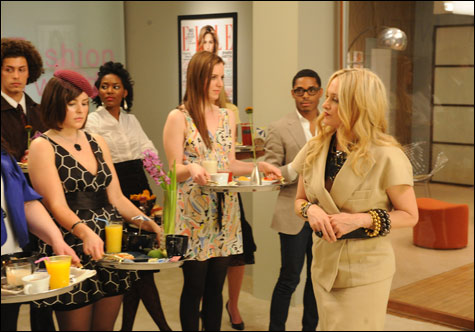
WEIRD SHIT: Stylista’s Slowey plays to the stereotypical editrix archetype by hamming it up as a Miranda Priestly–esque harpy. |
One of the accepted truths of the fashion world is that it’s utterly bizarre. So no surprise that this month’s fiscal apocalypse has done little to shatter the hopes of thousands of sharply dressed strivers who dream of toiling behind the scenes at a major fashion magazine. (Don’t believe me? Just read some of the electronically tear-stained posts on the Ed2010.com message board.) In fact, of late, the coveted gig of Fashion Editor has morphed into a professional Holy Grail. Particularly for anyone who’s ever watched Ugly Betty, The Fashionista Diaries, or The Devil Wears Prada, rolled his or her eyes heavenward, and sighed, “OMG, I could do sooo much better.”
It’s also a given that people who succeed in fashion like pain; what’s more, they enjoy learning how to manage and manipulate it. Anne Slowey and Rachel Zoe — the respective stars of Stylista (CW, Wednesdays at 9 pm beginning October 22) and The Rachel Zoe Project (whose finale aired this past Tuesday on Bravo) — specialize in deflecting and absorbing the cruel agonies of their jobs. Much has already been written and gossiped about these shows, and though the details differ (in a masthead shake-up, Slowey gets blamed for undercutting former Elle fashion director Nina Garcia; Zoe was recently dubbed a “pox on humanity” by Times television critic Ginia Bellafante), the premise is the same. These women have chosen to put themselves forward as the face of two distinct fashion brands, and thus they’re fair game for the kind of vicious public judgment usually reserved for badly photo-shopped actresses, designers entering rehab, and models who eat dirt on the catwalk.

Stylista follows 11 naive fashionistas vying for a one-year junior-editor spot at Elle under Slowey, now the fashion-news director, and creative director Joe Zee. Slowey plays to the stereotypical editrix archetype by hamming it up as a Miranda Priestly–esque harpy. After entering and tossing her coat onto a faceless assistant’s desk, she strides into a room, purses her vamp-red lips, and doles out a cold little introductory speech: “If you’re going to live in my world, you either get it or you don’t. So let’s see if anyone gets it.” Challenges range from preparing her breakfast tray (“I only do almonds if they’re soaked overnight”) to dressing mannequins with pre-selected pieces. The contestants themselves are immature and tediously bitchy; Slowey’s staged, sniping critiques of their work actually feel refreshing by comparison.
But some of the aspiring sartorialists talk about fashion with the same reverent awe as Zoe, a veteran Hollywood stylist-turned-household-name. The Rachel Zoe Project is less a reality show than a docudrama about a woman who has risen to the top without becoming jaded. Like Slowey, Zoe portrays herself, for her brand’s benefit, as a caricature and an anti-heroine. Sure, she looks patently ridiculous clutching a Starbucks Venti in a tiny hand festooned with vintage cocktail rings, drowning in her fur capelets, and barking at her assistants to “figure it out” while scrolling through her BlackBerry. Still, she has a soft side that’s pure entertainment. When she sits front row at a New York Fashion Week show, it’s all she can do not to hold back a girlish grin of delight. It seems to me — and before long it may to the young Stylista competitors — that taking whatever pleasure one can out of an industry this absurd is the only way to survive. Otherwise, all you have is a bad attitude and a closet full of really weird shit.